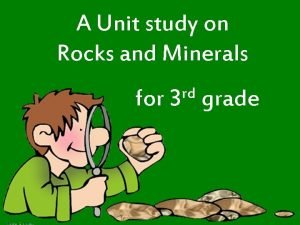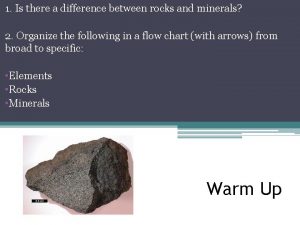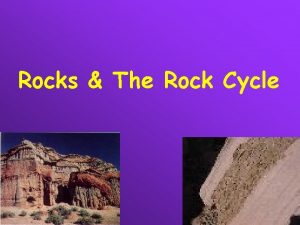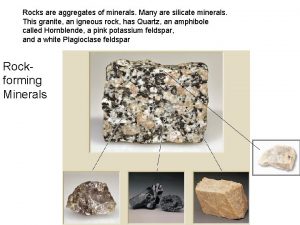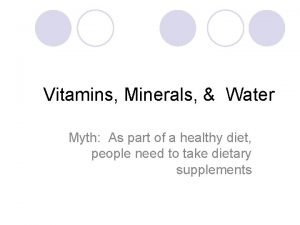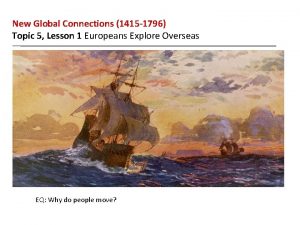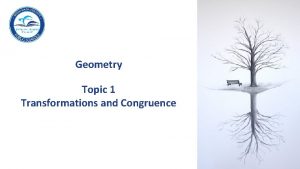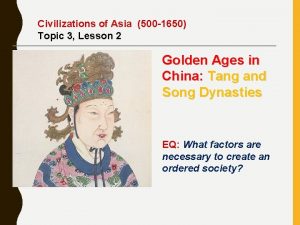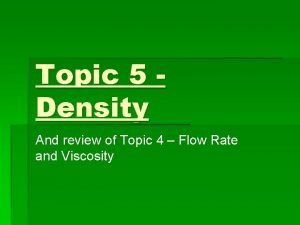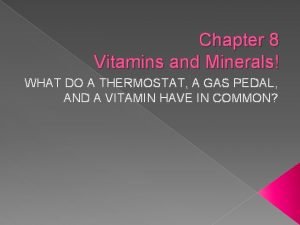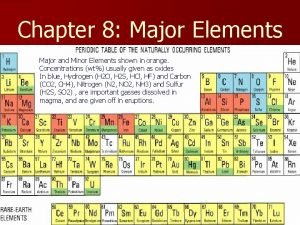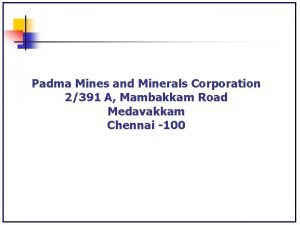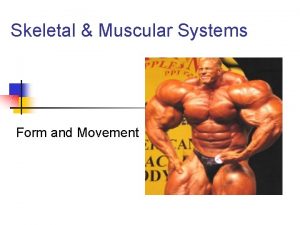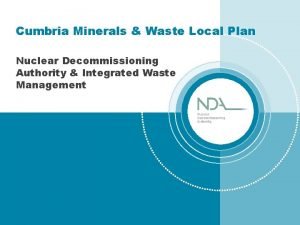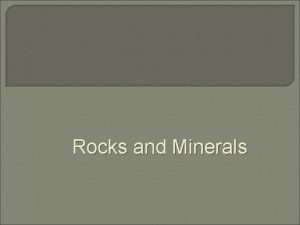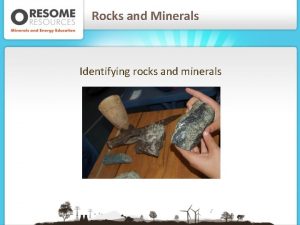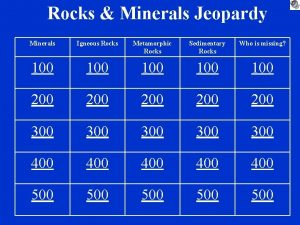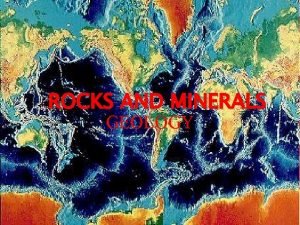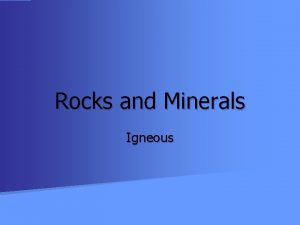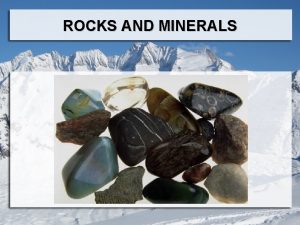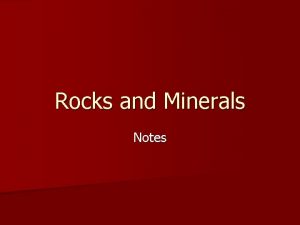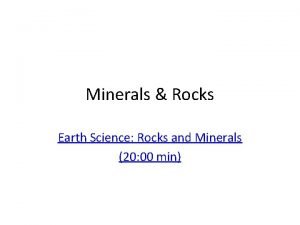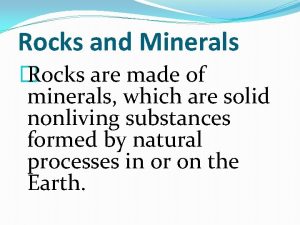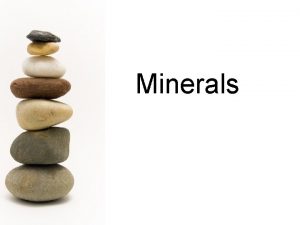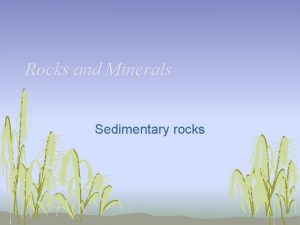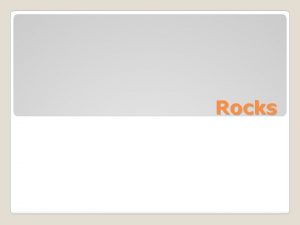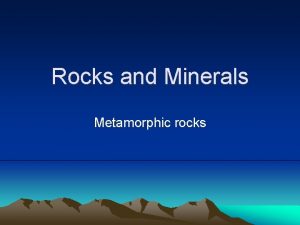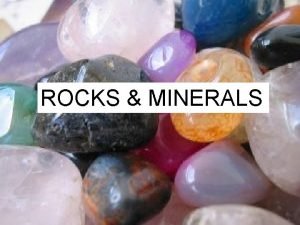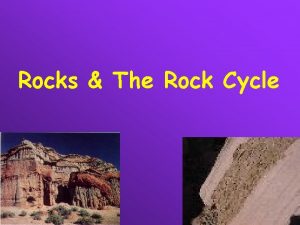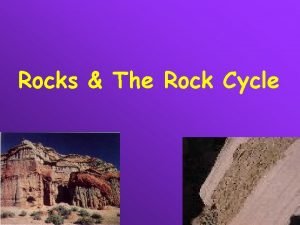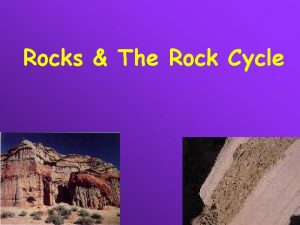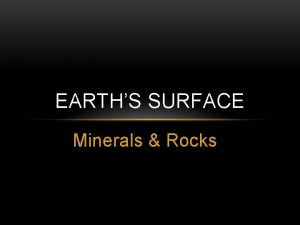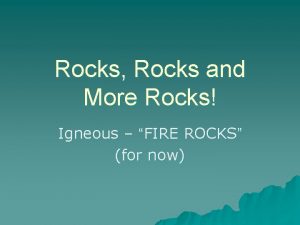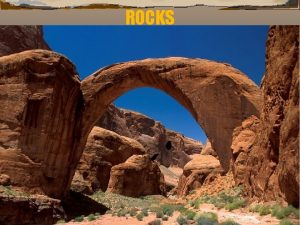Topic 3 Review Minerals and Rocks in the


























- Slides: 26

Topic 3 Review Minerals and Rocks in the Geosphere

Four Corners Rules • Go to the corner that matches your answer to the question! • Walk, do NOT run when moving from corner to corner. Do NOT push, trip, or touch each other in any way. • Be prepared to defend your answer! I will be asking follow-up questions for each question. • You should raise your hand to answer or ask questions. I will also call on you randomly. • Pay attention to the bolded words. • If you pay attention today, it will help you for the test tomorrow… trust me, I made both! • If you don’t pay attention today, you will lose a participation point and have to answer review questions from the book.

A mineral has all of these properties except… A. Organic B. Solid C. Definite structure D. Definite chemical composition Minerals are solid, inorganic, and have a definite structure (crystals) and definite chemical composition (elemental make-up).

This is the thickest layer of the Earth. A. Outer Core B. Inner Core C. Mantle D. Crust The Mantle thickest; the Crust is the thinnest. Order from outside to inside: Crust, Mantle, Outer Core, and Inner Core.

This refers to how difficult it is to scratch a mineral. A. Non-metallic Luster B. Hardness C. Density D. Streak Color Hardness: how hard it is to scratch Luster: how light reflects Metallic: shiny like metal Non-metallic: does not look like metal Color Streak: color of mineral when scratched on plate to make powder How they break: Cleavage: breaks into sheets (flat, straight) Fracture: breaks with rough, jagged edges Specific Gravity/Density: compares mass and volume of mineral Unusual: maybe smell or magnetism

This kind of rock can. This image shows subduction, one way that tectonic can interact. This results in a lot of heat and form underground plates pressure, making metamorphic rocks. If there is as a result of enough heat the rock melts, it will cool underground and become intrusive igneous rock. If tectonic plates the question said aboveground, then the answer would be extrusive igneous rock. colliding. A. Extrusive Igneous Rock B. Sedimentary Rock C. Metamorphic Rock D. Intrusive Igneous Rock

What happens to a rock’s matter as it changes from one type to another? A. It is recreated B. It has different atoms C. Rocks don’t change type D. It changes form Law of Conservation of Matter: Matter is neither created nor destroyed. It changes form and/or organization. Rocks can be destroyed and created, but their matter is not.

The Earth’s Outer Core is responsible for which process? A. Movement of the Tectonic Plates B. Creation of Igneous Rock C. The Earth’s magnetic field D. The rotation of the Earth Spinning of the Outer Core around the Inner Core causes magnetic field. Convection (movement) of the Mantle causes movement of the Tectonic Plates.

How do you calculate something’s density? A. Mass ÷ Volume B. Mass X Volume C. Volume – Mass D. Volume ÷ Mass Density compares how much space (volume) a certain amount (mass) of takes up. Therefore, mass is divided by volume.

What kind of break does this mineral show? A. Metallic B. Extrusive C. Cleavage D. Fracture: mineral breaks with jagged edges Cleavage: mineral breaks into flat sheets

Which of the following processes creates sedimentary rock? A. Heat B. Weathering and Erosion C. Deposition, Compaction, and Cementation D. Cooling Other rocks are broken down (weathered) into sediment and then moved (eroded) so that it can be put (deposited) somewhere else. Then, as more layers form on top of the sediment, it is pushed (compacted) together until they are actually stuck together (cemented).

Which of the following processes cannot happen, according to the Rock Cycle? A. Igneous Rock becomes Igneous Rock B. Sedimentary Rock becomes magma C. Metamorphic Rock weathers into Igneous Rock D. Extrusive Igneous Rock becomes Sediment All rock types can become other rock types, but HOW it happens is important. Metamorphic rock can become Igneous Rock, but not by weathering. The Metamorphic Rock must be melted and cooled to become Igneous.

Out of which rock is Oceanic Crust made? A. Granite B. Marble C. Basalt D. Shale Basalt is an igneous rock that makes up much of the Oceanic Crust. Granite is another igneous rock that makes up much of the Continental Crust.

How do pressure and temperature change as you go deeper into the Earth? A. Pressure Increases, Temperature Decreases B. Pressure Decreases, Temperature Increases C. Pressure Decreases, Temperature Decreases D. Pressure Increases, Temperature Increases As you go deeper, more “stuff” if pushing down on you, increasing the pressure. Temperature also increases because there is more energy from pressure and friction deeper in the Earth. The increasing heat causes the Mantle and Outer Core to be Liquid. Even though the temperature is higher in the Inner Core than the Outer core, the Inner Core is Solid because the extreme pressure presses it into a Solid.

How does the Rock Cycle end? A. Extrusive Igneous Rock B. There is no end. C. Metamorphic Rock D. Cooling There is no beginning and no end to the Rock Cycle. It is a continuous, ongoing process that has been going on for billions of years.

Which of the following is not a feature scientists use to describe minerals? A. Streak B. Texture C. Color D. Chemical Composition Texture is used to describe rocks, not minerals.

Which word describes crystals that cool quickly? A. Large B. Intrusive C. Fine-grained D. Visible This is true for both rocks and minerals: when crystals have the time to cool slowly, they have the time to grow larger. Crystals that cool more quickly don’t have time to create large crystals. Intrusive Magma cools slowly because it’s underground Coarse-grained (large, visible crystals) Extrusive Lava cools quickly because it’s aboveground Fine-grained (small crystals that can’t be seen with your eyes)

Out of which rock is Continental Crust made? A. Granite B. Marble C. Basalt D. Shale Basalt is an igneous rock that makes up much of the Oceanic Crust. Granite is another igneous rock that makes up much of the Continental Crust.

Which of the following correctly describes magma/lava? A. Lava is above ground; magma is below B. Lava is hotter than magma C. Magma makes Extrusive Igneous Rock D. Magma is above ground; lava is below

Where would you expect to find Sedimentary Rock? A. Under a lake at the end of a river B. Where tectonic plates meet C. Inside a volcano D. Near where an earthquake happened Think about the processes that form the different types of rock. This will give you an idea about where to find them.

Where would you expect to find Metamorphic Rock? A. Inside a volcano B. Where tectonic plates meet C. In an area that is exposed to constant winds D. On the seashore Think about the processes that form the different types of rock. This will give you an idea about where to find them.

Which word describes the motion of the mantle? A. Conduction B. Crystallization C. The Rock Cycle D. Convection Because there is more heat deeper in the Mantle than closer to the Crust, there is a temperature difference between the upper and lower parts. Just like with boiling water or air, the hotter materials rise. But, as it get closer to the surface, it cools. (Think about how temperature changes as you go deeper into the Earth. ) This causes the mantle to move in circles up and down as the temperature changes. This movement is called convection.

Gems are cut, polished, and/or processed in another way to make them attractive so they can be used in jewelry, for example. What is a gem? A. A newly-found mineral B. The shape that minerals form C. A mineral that has been cut and polished D. A pretty rock Ores are large amounts of a mineral that can be gathered and used to drive a process. For example, coal is an ore that is gathered for fuel.

How do scientists classify rocks? A. Randomly B. By how they form C. By where they are D. By how they taste Scientists can talk about all these things when discussing rocks, but the three types (Igneous, Sedimentary, and Metamorphic) are classified by how they are formed.

Three layers of Sedimentary Rock formed: A: 5 Million Years Ago B: 10 Million Years Ago C: 3 Million Years Ago Where would you expect to find Rock A? A. Near the surface B. Beneath Rocks B and C C. Between Rocks B and C D. Mixed with Rocks B and C Scientists use the order of contents of the Earth to learn about the history of a location. The deeper the rocks, minerals, fossils, etc. , the older they are. The closer to the surface they are, the newer they are. Rock A has an age between Rocks B and C, so it would likely be found between them.

If you only wanted to perform one test to identify a mineral, which would get you the right answer most often? A. Density B. Hardness C. Color D. Weight Multiple and even many minerals can have the same color, streak color, hardness, luster, and cleavage/fracture. Only one mineral has a particular density or chemical composition.
 How does a igneous rock become a metamorphic rock
How does a igneous rock become a metamorphic rock Igneous rocks metamorphic rocks and sedimentary rocks
Igneous rocks metamorphic rocks and sedimentary rocks Song about igneous rocks
Song about igneous rocks Granite and basalt difference
Granite and basalt difference Difference between rocks and minerals
Difference between rocks and minerals Concept map of rock cycle
Concept map of rock cycle Poem about minerals and rocks 3 stanza
Poem about minerals and rocks 3 stanza Whats the difference between rocks and minerals
Whats the difference between rocks and minerals Rocks and minerals
Rocks and minerals Minerals vs elements
Minerals vs elements Rocks are aggregates of minerals
Rocks are aggregates of minerals Extrusive rock
Extrusive rock Andesite vs basalt
Andesite vs basalt Example of clincher sentence
Example of clincher sentence Tapic about internet
Tapic about internet Minerals and their functions sources and deficiency chart
Minerals and their functions sources and deficiency chart New global connections test answers
New global connections test answers Transformations and congruence
Transformations and congruence Topic 3 review questions civilizations of asia answers
Topic 3 review questions civilizations of asia answers Topic 5 review
Topic 5 review Chapter 8 vitamins and minerals
Chapter 8 vitamins and minerals What are the elements of major and minor minerals
What are the elements of major and minor minerals Absorbs water and minerals
Absorbs water and minerals Padma mines and minerals corporation
Padma mines and minerals corporation Stores minerals and anchors muscles
Stores minerals and anchors muscles Cumbria minerals and waste local plan
Cumbria minerals and waste local plan Resources that can be replaced
Resources that can be replaced




